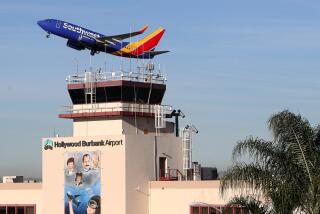Van Nuys Airport : Soundproofing of Homes Urged to Fight Noise
- Share via
Instead of requiring the city of Los Angeles to rezone residential neighborhoods around the Van Nuys Airport for industrial or commercial uses, the state believes insulating homes with sound buffers might be the best approach to noise problems, officials said Tuesday.
A state Department of Transportation attorney said the city Department of Airports had misinterpreted its original proposal for coping with noise at the city-owned airport. The proposal was based on an opinion delivered by an administrative law judge in mid-August.
“We never proposed that they had to do away with residential zoning or that they had to convert it to something else,” said Caltrans attorney Larry Thelen.
During a closed-door meeting Aug. 23, the state agreed to give the city three years to complete a federally funded study of airport noise and to begin working to lessen the impact of noise. At present, Caltrans and the city both favor sound insulation of homes.
The state’s bargaining power in the meeting was its power to withhold an extension of the airport’s “variance”-- a state permit to continue operating without meeting the requirements of state noise-limit laws. The airport’s variance expired in 1987. Without an extension, the airport would have to close.
‘Lack of Clarification’
Assistant City Atty. Jerome Montgomery blamed the state for contributing to the confusion about changing the neighborhood’s zoning through “a lack of clarification” of the state’s demands.
He attributed the compromise agreement in part to the city’s insistence that the state could not order it to change the zoning on the land, because that authority rests with the city Planning Commission and City Council.
“They don’t have the authority to do that,” Montgomery said. “How can you mandate an entity that doesn’t have any planning or zoning power to do those things? That didn’t make any sense from our perspective.”
In a second part of the compromise, the city Department of Airports agreed instead to urge the Planning Commission and City Council to change the general plan to describe the area as an airport-impacted zone, Thelen said.
“There are whole lots of people who don’t mind living in an impacted area at all,” Thelen said. “If they want to live there, fine. But we want them on notice of what they’re getting.”
However, the state maintained the right to turn that suggestion into an order if state authorities believe the city has reneged on its end of the bargain: To proceed promptly with the federal study, now set to begin with community meetings in September, and with its suggested solutions.
Don Schultz, president of Ban Airport Noise, said the city-state compromise was “a start, at least.” But he said that even if sound-deadening insulation is ultimately installed in an estimated 600 homes, it will not solve chronic noise problems of loud private jets and low-flying helicopters for everyone.
“That only helps the people who live within . . . the imaginary footprint area, who the airport feels are the most impacted people,” Schultz said. “You could live just one-half block from the runway and your next-door neighbor might qualify for his house to be sound-proofed and you might not.”
Besides, Schultz said, insulation only helps when people stay inside.
“What do you do?” he asked. “Make yourself a prisoner in your own home?”
Montgomery said the city discussed three options with Caltrans: reducing the amount of noise air traffic generates, rezoning the surrounding residential area for industrial or commercial use, or installing sound-deadening buffers such as attic insulation, wall panels and double-paned windows in homes in exchange for noise easements from residents. The easements would grant the airport the right to make noise above the property and become part of its deed.
Montgomery said that trying to actually reduce aircraft noise is “an option, but one that we don’t know we could accomplish.” He said that “residents out there wouldn’t like” changing the zoning to industrial or commercial.
That left insulation as the most feasible, he said, but he acknowledged that the federally sponsored study could come to a different conclusion.
The city can apply for Federal Aviation Administration funds to pay for 80% of the insulating costs, which Montgomery and Thelen estimated at $10,000 or more per building. About 600 houses and apartments are in the affected area now and Thelen said that if San Fernando Valley growth continues at predicted rates, that number could rise to 2,500 in the next decade.
On the strength of the new agreement, Thelen said, Caltrans will allow the city to continue to operate the airport, as long as it shows good faith by working on the federal study and trying to obtain federal grants to pay for the sound-buffer work.
More to Read
Sign up for Essential California
The most important California stories and recommendations in your inbox every morning.
You may occasionally receive promotional content from the Los Angeles Times.










